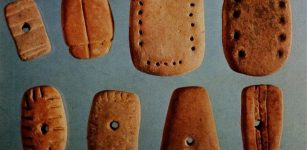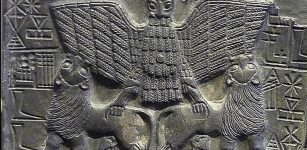Durendal – Magical Sword Of Knight Roland That Cut Stone Boulders With A Single Strike
A. Sutherland - AncientPages.com - One of the most famous swords in the history of humanity is the legendary Durendal, which belonged to Roland, Charlemagne's knightly champion and the hero of many French ballads, legends, and songs.
Alleged fragment of Durendal in Rocamadour. Image credit: Patrick Clenet - CC BY-SA 3.0
Charlemagne's mysterious sword "Joyeuse" contained the relics of saints. Also, the formidable Durendal had treasures like the hair of Dionysus of Paris (also Denis of Paris, a 3rd-century Christian martyr and saint), a tooth of St. Peter, part of the Blessed Virgin Marys garment, and the blood of St. Basil, hidden in the hilt of this magical sword.
These important and no doubt religious relics convinced the user/possessor of the weapon's extraordinary values in the fight, especially invincibility.
The name' Durendal' originates from the French word: "durer" ('endure'), but the whole combination may even be (durant – dail), in English, "strong scythe" with superb qualities including the power of withstanding hardship or stress, and resistance. Interestingly, 'Durendal' is a female name, and it is in femininity that the Knight refers to his weapon in ballads.
The Durendal sword was made of the finest metal alloys, and its qualities helped Roland deal with the attacking army of Muslims. It also contributed to other unusual achievements; for example, it could easily cut stone boulders with a single strike only.
According to one 12th-century legend from the French town of Rocamadour, Roland threw the sword into a cliffside, and its replica can be found there, embedded into the cliff-face next to the town's sanctuary.
Knight Roland received the magnificent Durendal weapon from King Charlemagne, king of the Franks and Emperor of the Holy Roman Empire when the young Knight took the oath. The sword is said to have belonged to young Charlemagne at one point and finally came into possession of Roland.
Credit: Lansing, Marion Florence, 1883 - Public Domain
The famous "Song of Roland' lets us believe that the legendary Durendal was first given to Charlemagne by an angel, but there are several theories on the origin of this sword.
Did the weapon once belong to Hector and was later given to Roland? Hector was a Trojan prince and the greatest warrior for Troy in the Trojan War in the mythologies of Greeks and Romans. He led his people and their allies in defense of Troy, killing countless Greek warriors. He was ultimately killed in single combat by Achilles. No doubt, Hector had his mighty weapons, but Durendal could not belong to this hero because all the swords dated to Hector's time were made of bronze.
It is commonly agreed that Durendal was created by Wayland the Smith, recognized as a highly-skilled craftsman, often mentioned in heroic romances, widespread in the noble courts of High Medieval and Early Modern Europe.
An invincible Durendal was forged from the same iron bar as King Charlemagne's 'Joyeuse' blade. This famous smith forged incredible weapons such as the Miming sword for his son Heime. He also created the precious sword Balmung for Sigmund, known from Anglo-Saxon poems, and yet another for the Volsung hero.
But it was not Durendal's fate to be destroyed. An 11th-century epic poem, The Song of Roland (' La Chanson de Roland,') describes Roland's attempt to damage his Durendal by hitting it against marble blocks to prevent it from being captured by the attacking Saracens. Once again, the sword proved indestructible, and after being mortally wounded, Roland hid it beneath his body as he lay dying along with the oliphant, an ivory hunting horn used to alert Charlemagne's forces.
Yet another legend dated to the 12th century tells us that Roland threw his sword into the rock to protect it from being taken by enemies, and the blade was firmly stuck in the stone. Nevertheless, residents of Rocamadour town in southwestern France still believe that a rusty sword sticking into the rock in one of the local monasteries is Durendal.
A more official version usually given to the visiting tourists is that the sword embedded in a cliff wall is a replica of Durendal.
Written by – A. Sutherland - AncientPages.com Senior Staff Writer
Updated on July 3, 2022
Copyright © AncientPages.com All rights reserved. This material may not be published, broadcast, rewritten or redistributed in whole or part without the express written permission of AncientPages.com
Expand for referencesReferences:
Cotterell A., Słownik mitów świata
Sayers Dorothy L. The Song of Roland
Cook, R. F. The Sense of the Song of Roland
More From Ancient Pages
-
 Bouboulina: Heroine, Wealthy Widow And Shipowner Who Commanded A Greek Fleet Against The Ottoman Empire
Featured Stories | Aug 30, 2019
Bouboulina: Heroine, Wealthy Widow And Shipowner Who Commanded A Greek Fleet Against The Ottoman Empire
Featured Stories | Aug 30, 2019 -
 A Scientific Surprise: Bering Land Bridge Formed Late During Last Ice Age
Archaeology | Dec 27, 2022
A Scientific Surprise: Bering Land Bridge Formed Late During Last Ice Age
Archaeology | Dec 27, 2022 -
 Intriguing Sumerian Clay Tokens – An Ancient ‘Book Keeping’ System Used Long After Writing Appeared
Artifacts | Jul 8, 2017
Intriguing Sumerian Clay Tokens – An Ancient ‘Book Keeping’ System Used Long After Writing Appeared
Artifacts | Jul 8, 2017 -
 Chaco Canyon’s Piedra del Sol Petroglyph Depicts An Ancient Total Eclipse Visible In The Year 1097
Archaeology | Aug 12, 2017
Chaco Canyon’s Piedra del Sol Petroglyph Depicts An Ancient Total Eclipse Visible In The Year 1097
Archaeology | Aug 12, 2017 -
 Babylon Excavation Uncovers 478 Artifacts, Including Cuneiform Tablets and Seals
Archaeology | Oct 17, 2024
Babylon Excavation Uncovers 478 Artifacts, Including Cuneiform Tablets and Seals
Archaeology | Oct 17, 2024 -
 2000-Year-Old Tomb Discovered In Northwestern China
Archaeology | Dec 7, 2015
2000-Year-Old Tomb Discovered In Northwestern China
Archaeology | Dec 7, 2015 -
 Man Finds A Viking Sword In His Garden – A Viking Grave Could Also Be Nearby – Scientists Say
Archaeology | Sep 2, 2022
Man Finds A Viking Sword In His Garden – A Viking Grave Could Also Be Nearby – Scientists Say
Archaeology | Sep 2, 2022 -
 On This Day In History: Independence Of Lower Canada – Today Quebec – Proclaimed On Feb 28, 1838
News | Feb 28, 2017
On This Day In History: Independence Of Lower Canada – Today Quebec – Proclaimed On Feb 28, 1838
News | Feb 28, 2017 -
 Headless remains related to Huns or Sarmatians puzzle archaeologists in Kazakhstan
News | Aug 30, 2015
Headless remains related to Huns or Sarmatians puzzle archaeologists in Kazakhstan
News | Aug 30, 2015 -
 Did Crassus, Ancient Rome’s Wealthiest Man Really Die From Drinking Molten Gold?
Featured Stories | Feb 15, 2017
Did Crassus, Ancient Rome’s Wealthiest Man Really Die From Drinking Molten Gold?
Featured Stories | Feb 15, 2017 -
 10 Ancient Chinese Musical Instruments You Didn’t Know About
Featured Stories | Jan 20, 2016
10 Ancient Chinese Musical Instruments You Didn’t Know About
Featured Stories | Jan 20, 2016 -
 Maat – Ancient Egypt’s Most Important Religious Concept
Egyptian Mythology | Apr 4, 2018
Maat – Ancient Egypt’s Most Important Religious Concept
Egyptian Mythology | Apr 4, 2018 -
 Unexplained Phenomenon In East Anglia – Ancient Mystery Deepens As More Unusual Sightings Are Reported – Part 2
Featured Stories | Jun 1, 2018
Unexplained Phenomenon In East Anglia – Ancient Mystery Deepens As More Unusual Sightings Are Reported – Part 2
Featured Stories | Jun 1, 2018 -
 Urukagina: Ruler Of Sumerian City Of Lagash And His Reforms To Combat Corruption
Civilizations | May 18, 2017
Urukagina: Ruler Of Sumerian City Of Lagash And His Reforms To Combat Corruption
Civilizations | May 18, 2017 -
 On This Day In History: Albertus Magnus – Medieval Person Of Great Historical Importance Died – On Nov 15, 1280
News | Nov 15, 2016
On This Day In History: Albertus Magnus – Medieval Person Of Great Historical Importance Died – On Nov 15, 1280
News | Nov 15, 2016 -
 Catherine Of Valois – Scandalous Queen Who Caused Drama Even After Her Death
Featured Stories | Feb 4, 2019
Catherine Of Valois – Scandalous Queen Who Caused Drama Even After Her Death
Featured Stories | Feb 4, 2019 -
 Mysterious Bones May Re-Write History Of North America – Humans Were Present On The Continent 10 Times Earlier
Archaeology | May 8, 2017
Mysterious Bones May Re-Write History Of North America – Humans Were Present On The Continent 10 Times Earlier
Archaeology | May 8, 2017 -
 LIDAR Technology Reveals Secrets Of Ancient Maya Civilization
Archaeology | Feb 3, 2018
LIDAR Technology Reveals Secrets Of Ancient Maya Civilization
Archaeology | Feb 3, 2018 -
 Gengen Wer – Goose God Who Guarded The Celestial Egg Containing The Life Force In Egyptian Beliefs
Featured Stories | Apr 22, 2021
Gengen Wer – Goose God Who Guarded The Celestial Egg Containing The Life Force In Egyptian Beliefs
Featured Stories | Apr 22, 2021 -
 Summer Solstice Festivals Around The World – Midsummer Celebration Is An Ancient Tradition Still Alive
Ancient Traditions And Customs | Jun 21, 2024
Summer Solstice Festivals Around The World – Midsummer Celebration Is An Ancient Tradition Still Alive
Ancient Traditions And Customs | Jun 21, 2024


